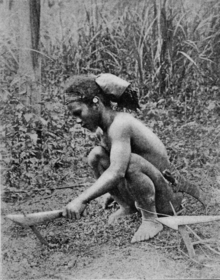 A Bugkalot man at work in clearing (c. 1910). | |
| Total population | |
|---|---|
| 18,712 (2020 census)[1] | |
| Regions with significant populations | |
(Nueva Vizcaya, Nueva Ecija, Quirino, Aurora, Northern Luzon) | |
| Languages | |
| Bugkalot, Ilocano, Tagalog, English | |
| Religion | |
| Animism, Paganism, minority Christianity | |
| Related ethnic groups | |
| Igorots, Ibanag, Ilocano, other Filipino ethnic groups |

The Bugkalot (also Ilongot or Ibilao[2]) are an indigenous peoples inhabiting the southern Sierra Madre and Caraballo Mountains, on the east side of Luzon in the Philippines, primarily in the provinces of Nueva Vizcaya and Nueva Ecija and along the mountain border between the provinces of Quirino and Aurora.[3][4][5][6] They are also commonly referred to as "Ilongot", especially in older studies, but nowadays, the endonym Bugkalot is preferred in modern ethnic research.[7] They were formerly headhunters.[7]
Presently, there are about 18,000 Bugkalots according to the 2020 census.[8] The Bugkalots tend to inhabit areas close to rivers, as they provide a food source and a means for transportation. Their native language is the Bugkalot language, spoken by about 6,000 people. They also speak the Ilocano and Tagalog languages, both spoken in Nueva Ecija and Aurora, with the former also spoken in Nueva Vizcaya and Quirino.
- ^ "Ethnicity in the Philippines (2020 Census of Population and Housing)". Philippine Statistics Authority. Retrieved July 4, 2023.
- ^ Barrows, David P. (1910). "The Ilongot or Ibilao of Luzon". Popular Science Monthly. Vol. 77, no. 1–6. pp. 521–537.
- ^ "Encyclopedia.com: Ilongot". Archived from the original on 2024-04-25. Retrieved 2024-04-25.
- ^ [1]
- ^ Mesina, Ilovita. "Baler And Its People, The Aurorans". Aurora.ph. Retrieved February 21, 2018.
- ^ Baler During Spanish Occupation in Aurora.ph
- ^ a b Mikkelsen, Henrik Hvenegaard (2016). "Chaosmology: Shamanism and Personhood Among the Bugkalot" (PDF). HAU: Journal of Ethnographic Theory. 6 (1): 189–205. doi:10.14318/hau6.1.013.
- ^ "Ethnicity in the Philippines (2020 Census of Population and Housing)". Philippine Statistics Authority. Retrieved July 4, 2023.
